WILDER SIDE OF OAKLAND COUNTY
September marks National Honey Month, a special time for honoring bees, beekeeping, beekeepers, and of course, honey! With those thoughts in mind, it’s a perfect time to share observations and discoveries from my newbie adventures into the world of beekeeping in northern Oakland County.
Our natural world is full of spectacular and beautiful creatures. One of them bears the scientific name of Apis mellifera, better known as the honey bee. Their very existence, an amazing and highly successful communal lifestyle, and the stories they share for those that have the patience to watch and willingness to learn, bring to mind the timeless words of Charles Darwin:
“ from so simple a beginning endless forms most beautiful and wonderful have been, and are being evolved.” – The Origin of Species, (1859)

Four months have passed since I dove headfirst into the world of beekeeping. I quickly discovered the water is deep and the waves can be high. My knowledge base to sink or swim was low, and for the first few weeks I wondered what the heck I was doing. However, with the help of another novice beekeeper, who enthusiastically partnered with me in this grand adventure that ignites the senses, and some experience-based advice from a commercial beekeeper friend who operates the Honey Lake Bee Company, I am still swimming and gaining strength. I think the hive is too.



My hive is a rather unique Australian product known as a Flow Hive that has, among other interesting features, three viewing ports that allow me to spy on some of their clandestine activities.


The bee smoker is the beekeeper’s best friend and constant companion at the hive, especially for a novice beekeeper like me. The moment a hive is disturbed, bees become restless and release an alarm pheromone that shouts, “danger!” The smoke masks the alarm pheromone and also instinctively makes bees think there is a fire. They will then start to gorge themselves on honey since they believe they will have to flee. Every time I open the hive, I create gentle puffs in the entrance, and once I begin to remove the frames for inspection, between the frames. The smoke keeps the bees and myself calm, and that’s a good thing. I use dry pine needles from my woods mixed with commercially purchased, unprocessed cotton to fuel the smoker. The pine needle scent tends to linger on our bee suits as well, but it’s not intentionally sprayed on them.

Although I have yet to harvest any honey, harvest day will come. If not this season, then maybe next summer. For in the first year of any beekeeping venture, it is critical to ensure the bees have enough honey to sustain them through the winter. At this point in time I am unsure, but it’s not likely.
Beekeeping has finally made me more attuned to subtle changes in the natural world in more ways than can be imagined: what flowers bloom when and the colors of their pollen, and what potential predators roam or fly near the hive. My short list of predators includes, dragonflies, kingbirds, and skunks, and I have fortified the hive with a treatment against one clear and present danger for all Oakland County beekeepers, the Varroa destructor mite. I’ve yet to have a problem with skunks, and the occasional loss of a bee to a bird or dragonfly is not consequential to the hive. Boldly yellow and black striped yellowjackets sometimes zip in fast and low to fly off with dead bee larva or a dead adult bee that had been unceremoniously tossed out of the hive by worker bees that function as undertakers.
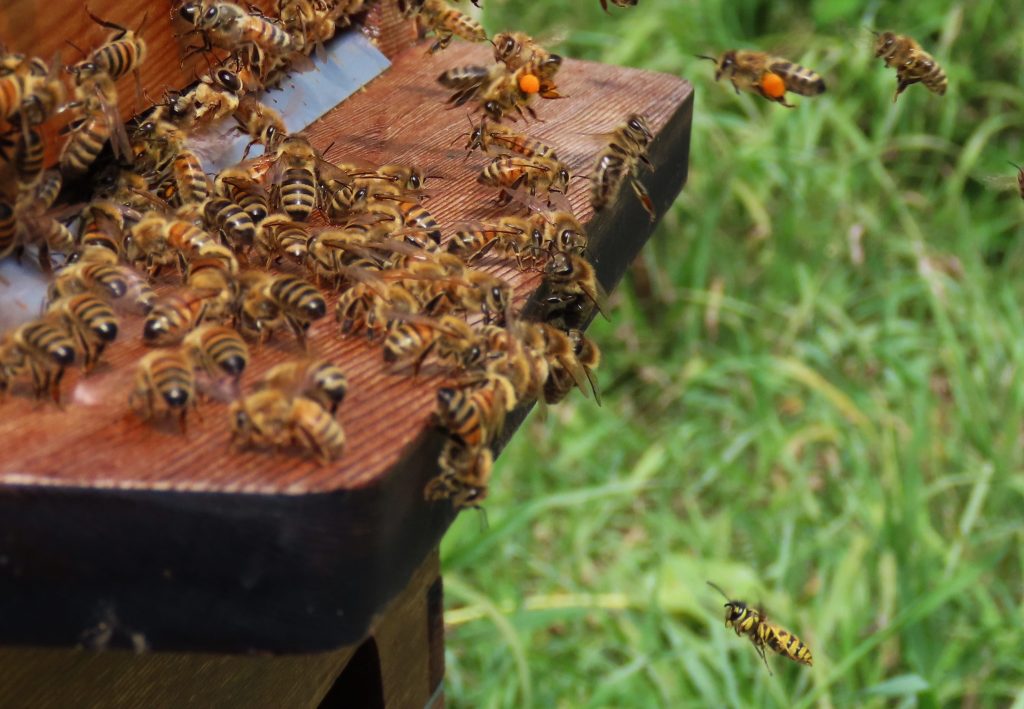
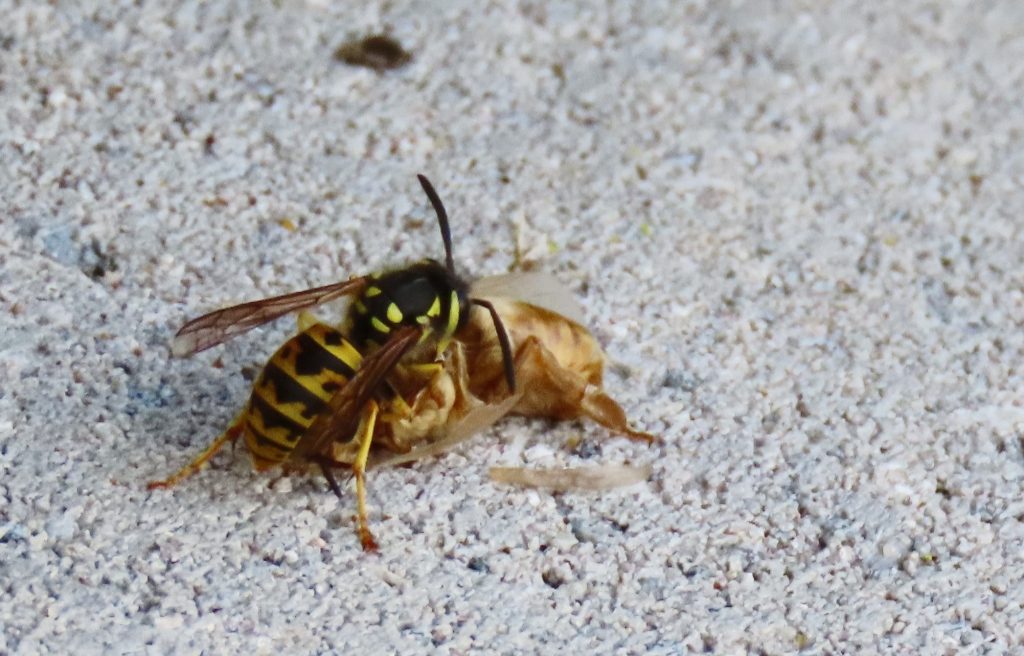
Right: a boldly colored, yellow and black, yellowjacket flying below the hive platform
The duel between summer and autumn is accelerating, making early September a good time to share some of my observations and novice beekeeper thoughts. Beekeeping can quickly transform from a confused thought process, with beads of sweat on my forehead and a racing heartbeat, into a passionate and rather comfortable obsession. I take comfort in knowing that honey bees in the wild do quite well without human interference. It’s up to me to interfere in ways that only sustain or aid them, not threaten the evolutionary ways that have led to their mutually beneficial existence with flowers, trees, and crops through pollination work.
I’ve also made a truly startling discovery through extensive reading on the art of beekeeping.

As I worked on a final version of this bee blog and prepared for another inspection of the brood and honey frames, my hive appeared to be doing very well. Thousands upon thousands of worker bees were zipping in and out on foraging missions from dawn to dusk and coming home with nectar and pollen to feed the brood and prepare for winter. At times, it looks like they need air traffic control at the hive entrance.
That is not the startling part. This is: If I was to leave town today and not return for four or five weeks, every single worker bee in the hive that was flying when I wrote this and coming home with their cargos of pollen and nectar would be dead. However, I would never note their absence since the hive is not about the individual, perhaps with the exception of the queen bee, but of the colony as a whole. To put it another way, the bees I have in September, will not be the bees I have in November, yet it will appear that they are all there, plus a few thousand more.

Confused? Don’t be. Here’s why and what happens:
It takes approximately 21 days for honey bee workers to go through the process known as complete metamorphosis, the transformation from a tiny egg to an adult worker bee. Worker bees are female and during the first few weeks of a worker bee’s life she, and maybe 20 or 30 thousand coworkers, will work within the confines of the hive in a great variety of roles including, nursemaid, queen attendant, climate control expert, undertaker, and guard. For the next few weeks they will forage for nectar and pollen to support the colony. For in reality, the colony is a superorganism and a worker bee is just a tiny part of the whole. When a worker bee is about six weeks old, she will die of exhaustion with torn wings and a depleted body. The superorganism, the bee colony, will live on and thrive if the beekeeper (that’s me) does all the right things. I am trying hard to do the right things.
Drones are male honey bees that also live in the hive and develop from unfertilized eggs. They are larger and heavier than worker bees and usually are about 10-15% of the hive population. They do not have stingers and do not forage for honey or nectar, nor do they produce wax, or even guard the hive entrance. Their primary function is to mate with a queen that is not from their own hive. However, a drone that successfully mates with a queen dies from the act. Most of those that do not mate with a queen, meet their end as the frosty days of autumn arrive and the season of reproduction ends. They are forced out of the hive by worker bees where they quickly die of exposure. I agree with the words of Kim Flottum in The Backyard Beekeeper, 4th Edition: An Absolute Beginner’s Guide to Keeping Bees in Your Yard and Garden, (2018), “their retirement plan isn’t very good.”
Here are some other things I have discovered or observed as I pursue my new passion.
RELAXATION
It’s pure relaxation sitting on the bench that I have in place just 10 feet from the hive entrance and slightly to one side of their direct flight path. I sit there without wearing my beekeeping suit. I watch. I discover. I learn. I sip coffee. It’s a perfect way to start the day.

THE QUEEN
Up until September 7th, I had only seen the queen bee once. That day was back in early May when we transferred the bees to my empty hive from a nuc I purchased from Sandhill Bees in Munith, Michigan. A nuc is a small, partially developed colony with a queen, some stored honey and pollen, and a few thousand bees in search of a permanent hive. It’s made of double wall corrugated cardboard. We drove home to my meadow, trying to carefully avoid bumps and fast stops on the eighty mile drive that included several sections of rough gravel roads. The queen is the longest and largest bee in the hive and she has a blue dot, a marker added by the beekeeper. Although I had not seen the queen since day one of our beekeeping adventure, I knew she was alive since the colony was growing and during my twice a month inspections of the hives interior, I noted more eggs and larvae. The queen is the supreme ruler of the hive with two primary purposes: laying eggs (over 1,000 a day at times) and producing pheromones that help regulate the cohesiveness of the colony. Finally, during our last inspection of the day, we saw her! She had just laid an egg and was moving about a frame we had just removed. Here she is in all her sunny day beauty with her blue dot clearly visible.
CLIMATE CONTROL
Honey bees are masters of climate control and must maintain a constant hive internal temperature of approximately 95 degrees to raise the brood. A beehive in the sun can heat up quickly and some bees will then exit the hive and gather on the outside in a process called bearding, in an attempt to ease crowding and keep the hive cooler.
My commercial beekeeper friend, Brian, shared heat control advice with me and I added a temporary shade shelter to ease their work load as other bees fanned from the entrance.
I discovered later that worker bees had the situation under control and transported in water to create a thin film of moisture near the edges of the brood comb. They then fanned inside the hive creating “evaporative cooling,” or in terms we all understand, “air conditioning!”
HONEY
Most people know that bees make honey, but if you’re new to beekeeping you may not know some of the incredible facts about how it’s made. I did not. Here’s the tale in short: Bees have two different stomachs, one for digestion and one for nectar storage when sipping from flowers and flying back to the hive. When they return to the hive, they pass the nectar among each other in what has been described playfully as a game of “regurgitation telephone” that adds enzymes and helps transform the nectar into honey. Fanning of wings accelerates the evaporation process once the nectar is placed in a cell. That cell is then capped with wax and seals in the finished product, honey. This 90 second cartoon video for kids from Smart Living for All clarifies the process with humor.


POLLEN
Pollen is collected as a protein source for the honey bee colony. While nectar provides energy, pollen provides everything else the bees need for survival: protein, lipids, vitamins, minerals, antioxidants, and trace elements. Without protein, no young bees, known collectively as brood, could be raised and the colony would die. Pollen collection is an amazing process.
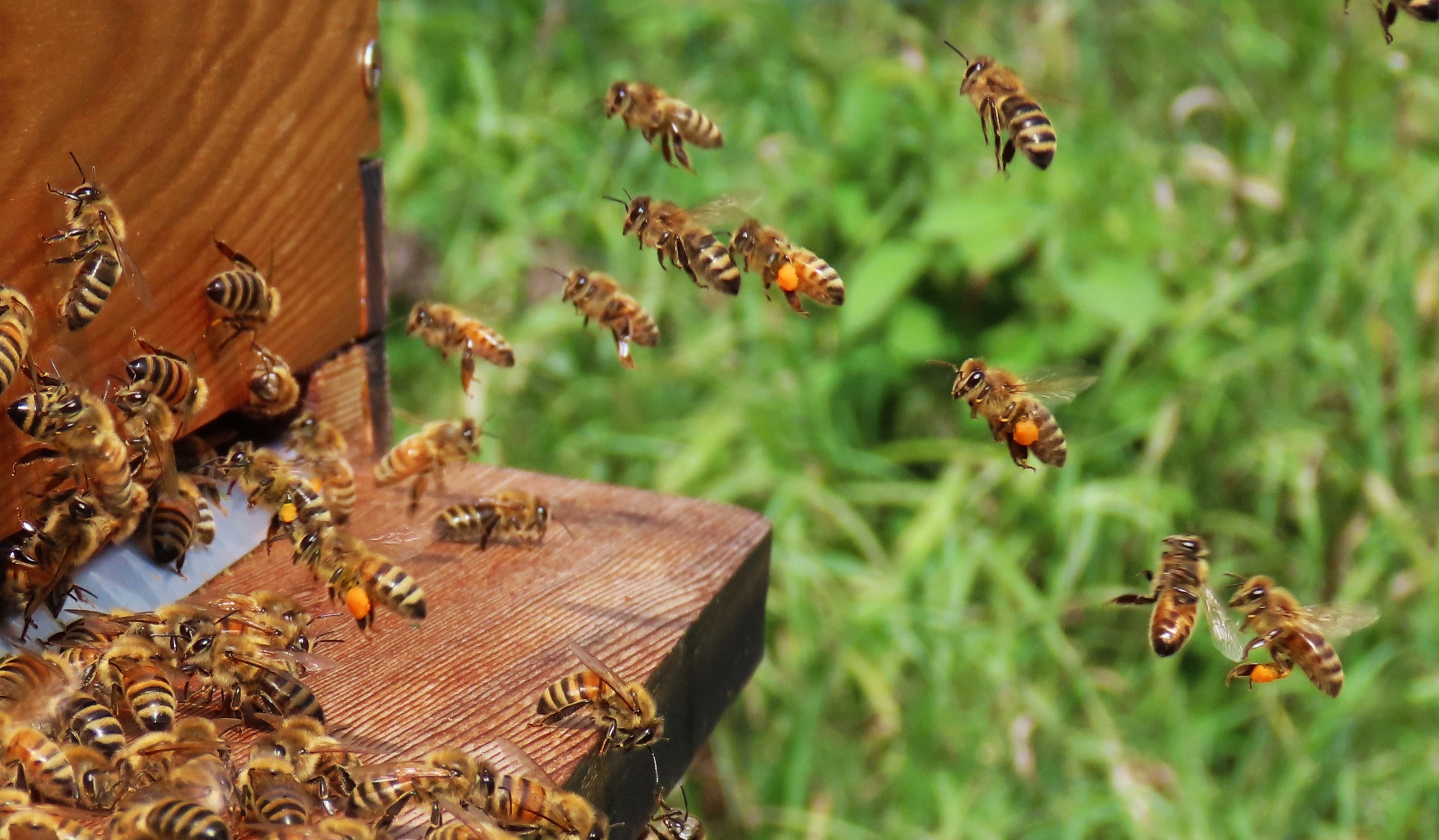


The foraging bee lands on flowers and moistens her forelegs with her tongue. She then brushes pollen from her body and forelegs to the pollen comb on her hind legs from where it is then compacted into the “pollen basket” for the return flight to the hive as food for the brood.

WINTER BEES
Winter bees are workers that emerge near the end of the foraging season. Rather than living six weeks like most of their summertime sisters, winter bees may live six months and are the bees that will determine whether our colony will survive the winter. Honey bees born in spring and summer live about five or six weeks, but the winter bees born later this month, or in early October, may survive for five or six months with most of their life spent inside the hive. The winter bees have a substance known as vitellogenin that is produced in the fat bodies of bees and has multiple functions and increases lifespan. The winter bees will be feeding on stored honey, and clustered together they’ll actively vibrate their bodies to create warmth to ensure the survival of the Queen and the rest of the colony.
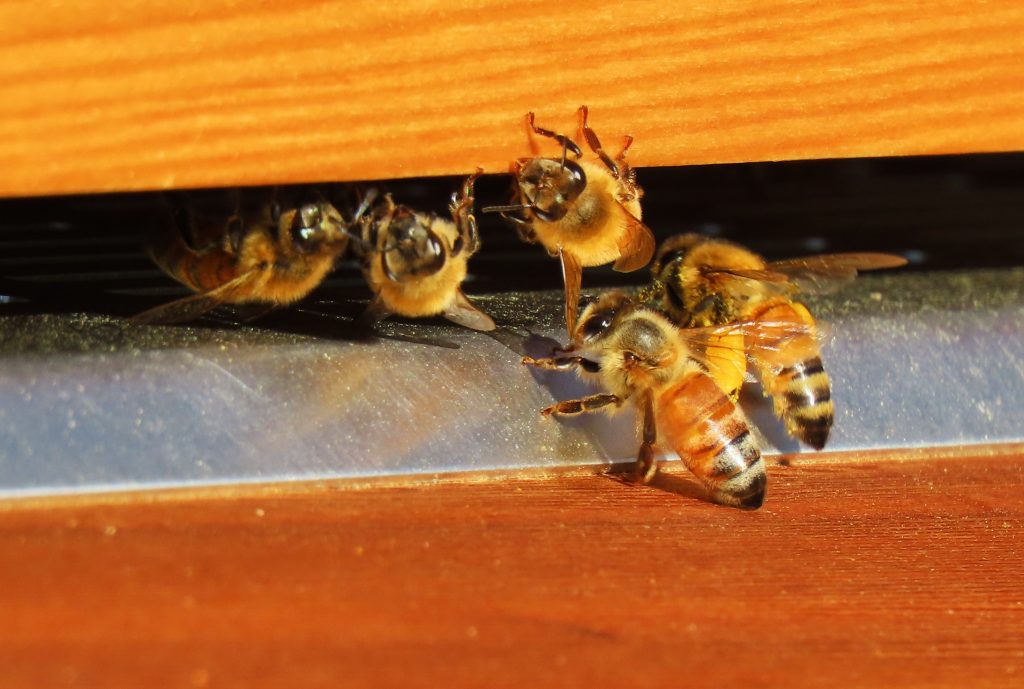
Autumn is rapidly approaching and my forays to the hive for observations and inspections will slow with the seasonal change. Once the temperature stays below 55 degrees, the bees will cease most foraging and I will miss my daily external observations. I will certainly miss the sweet smell of pine needle smoke from the bee smoker that lingers on our bees suits, the scent of aromatic honey wafting from within the hive, and the excitement of stolen tastes of honey we sample when some drips out during physical inspections of the hive’s frames. Perhaps my most important discovery from my first four months as a beekeeper are the words of Stephen J. Repasky, the author of Swarm Essentials, (2013):
“Beekeeping is both an art and a science. Science is the knowledge, but art is the application of all of this information.”
The art remains a work in progress in my corner of the wilder side of Oakland County.


Jonathan Schechter is the nature education writer for Oakland County Government and blogs weekly about nature’s way on the Wilder Side of Oakland County.
Follow along with Oakland County on Facebook, Instagram, LinkedIn, Pinterest, Twitter, and YouTube using #OaklandCounty, or visit our website for news and events year-round.



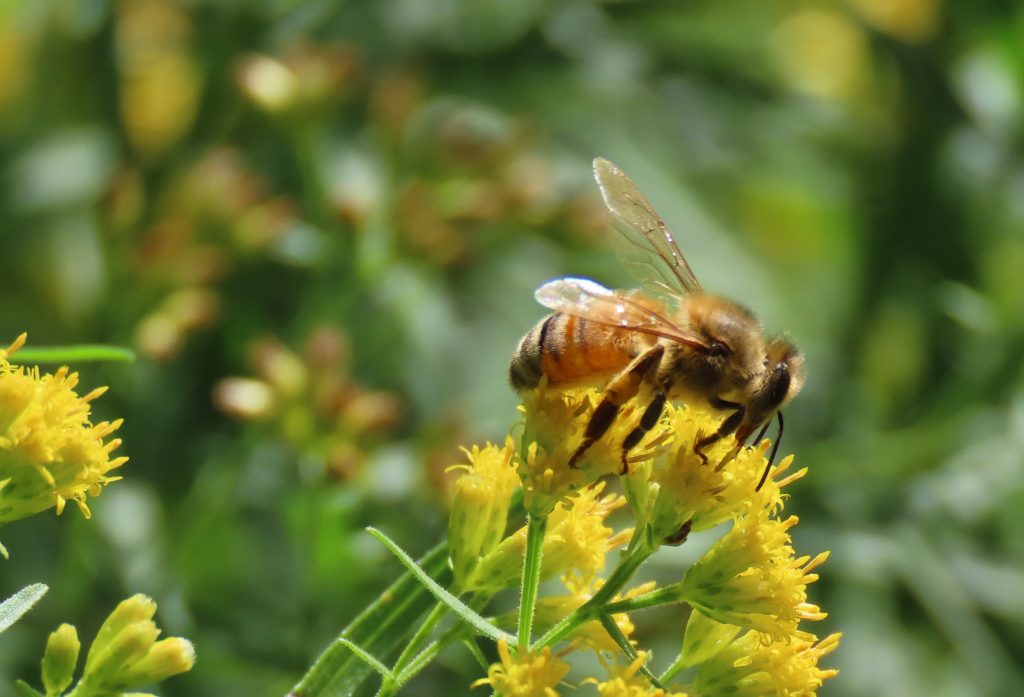

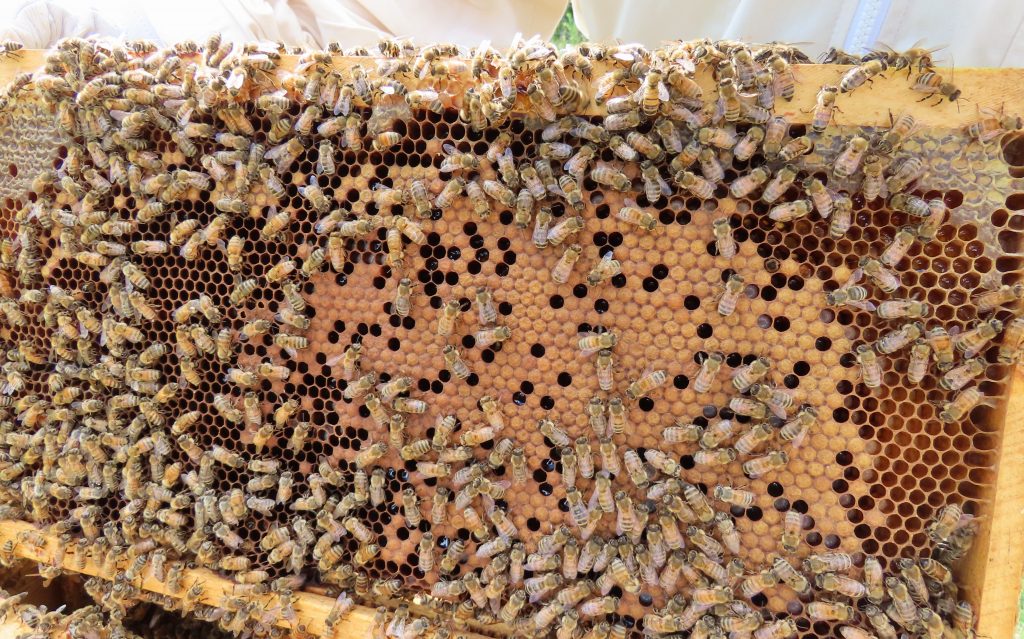

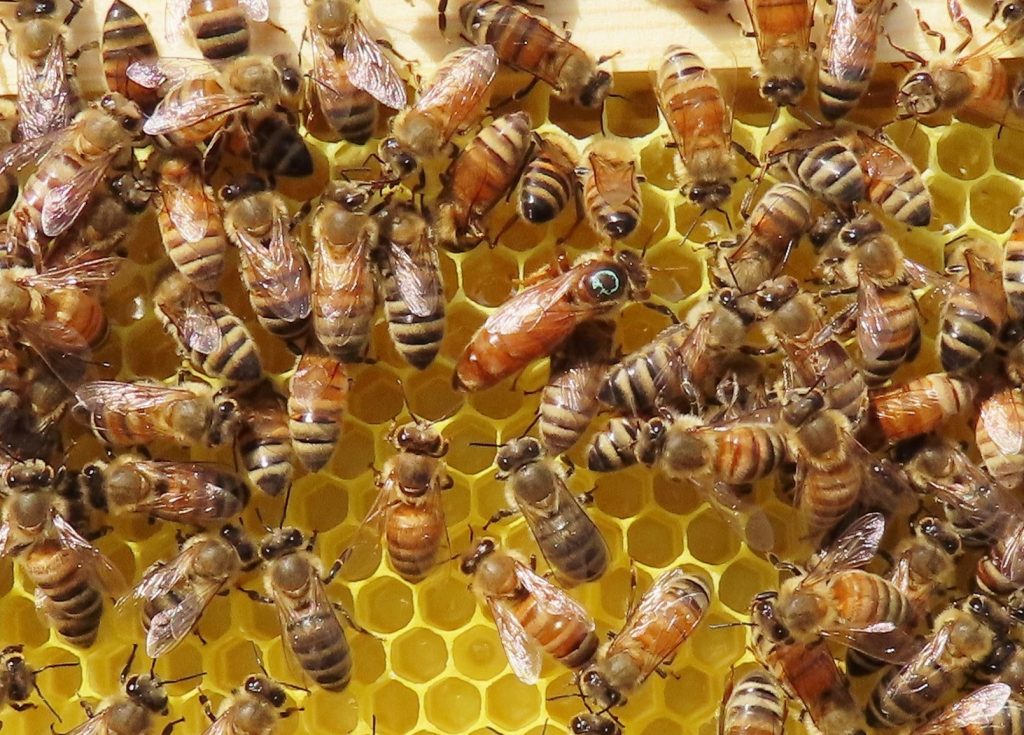
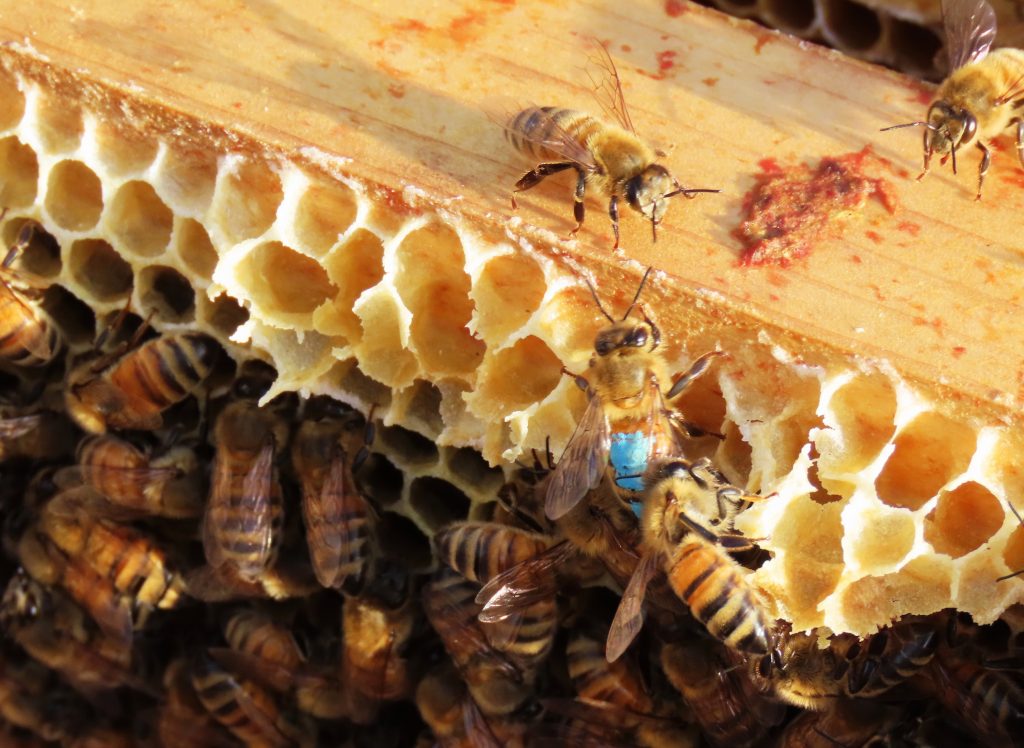
Awesome article!
Inspiring! Would love to try that out one day!